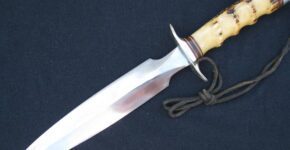

Published in RKS Newsletter 69 January 2006
A sale of a Randall and the ensuing conversation with the purchasing collector brought something to my attention that I had never really given too much thought. It was regarding perspectives of different individuals when it comes to selecting a Randall knife for their collection. I just hadn’t taken too much notice of how others may view the same knife and how that view may be different from mine. What made it really interesting for me is I was in his position at one time with same knife when I originally purchased it. This article grew out of the collector’s take on the knife as being ‘different’ from the accepted ‘standard’. It also begs the question then, what is the accepted standard?
In recent years there have been several excellent publications and much research into the various nuances of Randall Made Knives. The information currently available is vastly superior to what was available as little as four to five years ago. We must remember that most of the publications are intended to be references, not scripture. The RKS newsletter has also been a good source over the past few years with better articles containing more accurate information.
Many of the publications contain good photographic examples of knives that exhibit a ‘standard’ example of a specific model. Some with accompanying text will convey this message and point out the traits considered standard for the model, and/or period. They do illustrate there was an effort on the part of RMK to have a standard configuration for the knives made. These publications also show examples of ‘non-standard’ knives and their traits. Some non-standard traits may be somewhat inconsequential while other traits are options or were a ‘standard’ done only for a short time and both can put a knife into a different level of collectibility. Often available Randall options are used to create a ’custom’ knife to suit one’s own aesthetic taste and/or use requirements. Of course when this was done in the past, say from the 70’s back, it most likely wasn’t done with the intent on creating a collectible but only a personalized knife. Knives with some of these options can of course command a premium but that is for another discussion. What I want to discuss here is that the simple variation from the accepted standard can sometimes make for a neat piece to the collector.
‘Oddball’ spacer arrangement similar to what a late 70’s to early 1980’s vintage piece – thick center spacer – would have.
‘Standard’ spacer arrangement
Let’s say we have two similar knives of the same model from the late 50’s, standard knives with leather handles. We know these knives will have a similar blade grind, handle, and hilt shape, with minor variations – the inconsequential kind. We also know that these knives should have a three thick two thin spacer arrangement at the hilt. What if one of the knives has something a bit different at the hilt, an odd spacer arrangement of two very thin red spacers with the white and blue spacers basically the same medium thickness? Does it make the knife a highly prized and rare collectible more so than the three thick two thin spacer ‘standard’ model? Probably not, but what it does show is that there are variations to a “standard” that are not an option but something else.
In this example, it was perhaps as simple as the RMK employee assembling this knife made a ‘mistake’ and used thin red and medium white material at the hilt, or maybe the shop was out of the thicker red material when this particular knife was assembled. In either case it makes for interesting conversation among collectors and gives cause to reflect on the inherent individuality of each Randall Made Knife.
Given the choice between the two knives in the example, I would likely be most interested in the “oddball” perhaps to study a bit, but it is not significant enough to pay a premium for it. These small and seemingly obscure variations from ‘standard’ in Randall Made Knives help lend to the credibility of the term “Hand Made.”